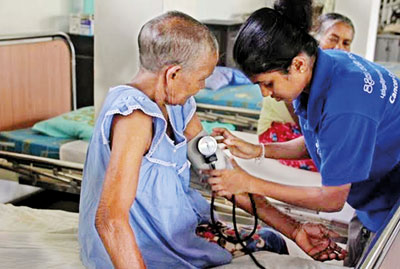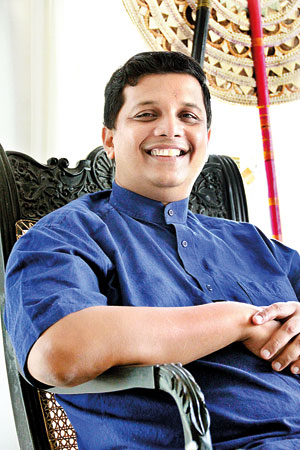Sunday Times 2
In Sri Lanka, only a few patients with life limiting illness still receive proper palliative care
When Lalith’s wife, a medical officer, admitted him to the Institute of Palliative Medicine in Matara, he was in severe physical distress. He had suffered several brain haemorrhages, and had renal failure, fungal infections, an eye infection, pneumonia, a tracheostomy in his throat and a deep bedsore. Lalith had to be fed through a PEG tube in his abdomen.
Amila, Lalith’s wife, says, “I was able to do my work as an anaesthetist and look after our two teenage children because the Institute gave him all the necessary treatment and care. The care was so good, he improved.”

Palliative care: The medical team should work on all aspects of care such as pain management, other symptom management, counselling and even spiritual needs
According to the World Health Organisation (WHO), palliative care is an approach that improves the quality of life of patients and their families facing problems associated with life threatening illnesses. A hospice is a residential centre for patients in need of palliative care. It focuses on pain and other symptom management, as well as the social, psychological and spiritual needs of a patient who has a life limiting illness.
Every year, about 20 million people rely on palliative care at the last stages of their lives. Six percent of them are children.Yet one third of the people with terminal illnesses in the world have no access to palliative care.This can be seen in Sri Lanka too.
Around 68,000 people in Sri Lanka require palliative care, which is as many as 60 percent of all people who die in a year, says the Sri Lanka Palliative Care Association.
Palliative care and hospice support is still hard to find in Sri Lanka. Many of the facilities available focus on patients with cancer because of the large number of terminally ill cancer patients who need palliative care. Yet there are others who need palliative care such as patients with end stage kidney disease, heart failure, dementia and liver disease.

Dr. Samadhi Rajapaksa: Believes in holistic approach to palliative care
In Sri Lanka, a majority of end-of-life patients die in severe pain because of inadequate pain management. Morphine, the most commonly used drug in pain management, is still not easily accessible in Sri Lanka. This is because, while any licensed physician can prescribe morphine in Sri Lanka, adequate stocks and affordable forms of the drug are mostly available only in Government hospitals.
Most distressingly, people do not receive support and guidance from professionals on whether a patient needs curative care or palliative care. The Colombo University inaugurated a post graduate diploma in palliative medicine in 2018, but there is a significant need for more training for doctors, nurses and undergraduate medical students, says Dr Samadhi Rajapaksa, founder of the Institute of Palliative Medicine. He is also the Chairman of the National Authority on Tobacco and Alcohol.
In 2003, as an intern medical officer attached to the teaching hospital of Anuradhapura, Dr. Rajapaksa realised there was an immense need for developing palliative care services in Sri Lanka. He felt it was his responsibility to establish a palliative care service because the state was not providing it then.
“At that time, palliative care services were very limited in the country. The knowledge and interest in palliative care was inadequate even among medical professionals, and facilities were insufficient, too,” he says.
Today, the Institute of Palliative Medicine is one of the eight hospices in Sri Lanka. Of these, only one is run by the Government. All the others are privately owned and managed. Dr Rajapaksa is also the founder and Chairman of the Cancer Care Association of Sri Lanka, which has another hospice in Anuradhapura. “We run two of the eight hospices in Sri Lanka,” he says.
A patient who came to my clinic donated two acres of land for the Anuradhapura hospice. But raising funds to build the hospice was a challenge. So, one day, I decided to walk from Anuradhapura to Kandy and do a hat collection. It took me five days.The result was the 46-bed hospice worth 0.3 million dollars in Anuradhapura today, says Dr Rajapaksa.
People believe that they will not receive any treatment in a hospice, but that is a myth, he adds. In a hospice, the medical team will work on all aspects of care such as pain management, other symptom management, counselling and even spiritual needs.
“I believe in holistically supporting the patient and the family. We even support the families to try local rituals, Ayurveda or other local treatments,” says Dr. Rajapaksa who pioneered the home-based, palliative care system for end of life cancer patients in Sri Lanka in 2011. The home-based programme includes visits to patients’ homes with medicine, required therapists and even a hamper of dry rations for financially hard hit families.
This has proved to be a community palliative care model that fits well into Sri Lankan culture. Dr. Rajapaksa’s team expanded this model to the Northern Province in 2015, the North Central and Western Provinces in 2016, and are having discussions with communities to cover the Eastern Province in the future. “We are more than happy to see the development of home-based palliative care facilities in Sri Lanka by other organisations too,” he says.
Speaking at the annual oration of the Palliative Care Association of Sri Lanka, Dr. Rajapaksa called his system “low tech: high touch community-based palliative care.”
“When families can’t manage at home, we help them by moving the patient to our centres to care for them at the hospice,”says Dr Rajapaksa.
Few in Sri Lanka can afford the exorbitant rates charged for private nursing care, which is, at most times, provided by staff who do not have the training to give palliative care. “We do not charge anyone. Our services and medicine are given free to anyone who needs it,” Dr. Rajapaksa says.
The cost of providing one patient medicine, therapy, nursing care and food is Rs. 2,000 a day at the hospice and Rs. 5,000 for a home visit. “We need all the support we can get because the need is immense in Sri Lanka. Many homes have only one caregiver and that person can’t cope. When the sole income earner falls ill, most families become destitute,” he says.
When Amila brought Lalith to the Institute of Palliative Medicine, he scored eight out of 15 on the Glasgow Coma Scale that is used to measure a person’s consciousness after brain injury. A score of eight or less indicates severe injury. Lalith’s score has now improved to ten. “When our daughter sings to Lalith, he can now respond. He recognises her,” Amila says.
Because Lalith’s condition has improved beyond expectation, Amila was able to move him into rehabilitation care last week.
“There is no need for people to live with pain. Palliative care is about adding life to days; not just days to life,” Dr. Rajapaksa says.
The names of the patient and his wife have been changed to protect their privacy.
Please donate
Donations to the Institute of Palliative Medicine can be made through the Palliative Care Trust, AC. No. 1750044444, Commercial Bank, Homagama Branch, SWIFT Code: CCEYLKLX

